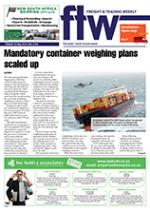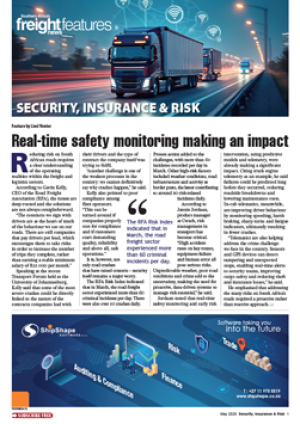Growth in the South African
airfreight industry will be
driven by regional integration
in the SADC region in
particular, in the view of
Hannah Edinger of Frontier
Advisory. This comes as
South Africa, specifically OR
Tambo International, plays a
significant role as the regional
hub for goods that are landed
from abroad, and then further
distributed into SADC in
particular,” Edinger said.
In addition, the SA Express
Parcels Association foresees
the impact of the cost of
e-tolls, deteriorating road
infrastructure and the everpresent
threats of hijacking as
challenges that may presently
weigh heavily on the local
road freight option.
“It would not be surprising
to see some commodities
returning to the high-speed,
high-security air sector,” said
Saepa CEO Garry Marshall.
Mainstay cargo categories
transported by express
freight across SA and into
Africa presently include
urgent machinery, vehicle
and aircraft spares as well as
consumer electronics.
However, Marshall said the
express airfreight sector was
not without its challenges,
such as the stringent
international cargo security
regulations, which have
transformed the industry.
“They affect personnel,
equipment and procedures
and impact on all parties in
the chain, from supplier via
service-provider and carrier
to consignee. SA is a signatory
to international bodies and
compliance is mandatory,”
Marshall said.
He added that this required
intensive education at all staff
levels within the industry and
the association was assisting
by putting staff through a
newly developed Certificate in
Supply Chain Management.
“A compartmentalised view
of express logistics, focusing
solely on the transport leg,
is not enough. Staff need
a wider perspective and
understanding of customer
business models,” Marshall
said.
According to Saepa the
technological revolution
has continued to impact
the industry, forcing service
providers to constantly keep
abreast of new developments.
Typical technological
advances have included:
• Ordering through on-line
channels, short-circuiting
traditional order and
re-order patterns
• Greater automation in the
acceptance and routing of
packages
• On-line signatures – proof
of delivery
• Satellite tracking for greater
vehicle efficiency and
security
Saepa foresees that the
industry will evolve to include
a greater number of industryspecific
service providers
with specialised equipment,
procedures and staff. For
example, cool-chain service
providers for extreme timeperishables
ranging from
medication to foodstuffs to
high-fashion items.
“It’s a young industry – the
first 40 years have already
been remarkable. With the
explosion of technology, the
next ten will be staggering,”
Marshall said.
INSERT 1
Challenges of delivering
on-line purchases
· In addition to durables, groceries are becoming a mainstream on-line
purchase and they require a different set of skills due to perishables and the
frequency of purchases.
· In SA suburban deliveries can be problematic because unlike industrial
parks, often no-one is home during the day.
· It is expensive to drop off one consignment at a time.
· Many people live in secure complexes where door - to-door delivery is
impossible.
· `Many impulse buyers focus on the purchase price of the item, without
realising that customs duty and clearance, VAT and other charges may be
levied, resulting in a surprise at point of delivery.
INSERT 2
Convenience of
online purchasing
· Consumers don’t have to waste precious working or leisure hours
travelling to various stores and malls to compare prices.
· They can buy at any time day or night without waiting for shops to open.
· The express freight industry fulfils the order conveniently by delivering to
home or office.

